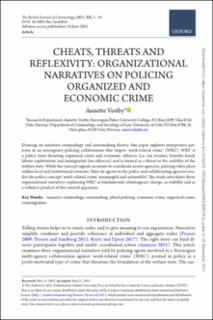| dc.contributor.author | Vestby, Annette | |
| dc.date.accessioned | 2021-10-19T06:17:55Z | |
| dc.date.available | 2021-10-19T06:17:55Z | |
| dc.date.issued | 2021 | |
| dc.identifier.issn | 1464-3529 | |
| dc.identifier.uri | https://hdl.handle.net/11250/2823757 | |
| dc.description | This is an Open Access article distributed under the terms of the Creative Commons Attribution-NonCommercial-NoDerivs
licence (http://creativecommons.org/licenses/by-nc-nd/4.0/), which permits non-commercial reproduction and distribution
of the work, in any medium, provided the original work is not altered or transformed in any way, and that the work is properly
cited. | en_US |
| dc.description.abstract | Drawing on narrative criminology and sensemaking theory, this paper explores interpretive patterns in an interagency policing collaboration that targets ‘work-related crime’ (WRC). WRC is a policy term denoting organized crime and economic offences (i.e. tax evasion, benefits fraud, labour exploitation and immigration law offences) and is framed as a threat to the viability of the welfare state. While the concept signals an intent to coordinate across agencies, policing takes place within local and institutional contexts. How do agents in the police and collaborating agencies render the policy concept ‘work-related crime’ meaningful and actionable? The study articulates three organizational narratives explaining WRC as fundamental criminogenic change, as stability and as a reflexive product of the control apparatus. | en_US |
| dc.language.iso | eng | en_US |
| dc.publisher | Oxford University Press | en_US |
| dc.subject | narrative criminology | en_US |
| dc.subject | fortellende kriminologi | en_US |
| dc.subject | sensemaking | en_US |
| dc.subject | plural policing | en_US |
| dc.subject | politiarbeid | en_US |
| dc.subject | economic crime | en_US |
| dc.subject | økonomisk kriminalitet | en_US |
| dc.subject | organized crime | en_US |
| dc.subject | organisert kriminalitet | en_US |
| dc.subject | crimmigration | en_US |
| dc.subject | krimigrasjon | en_US |
| dc.subject | meningsdannelse | en_US |
| dc.title | Cheats, threats and reflexivity: Organizational narratives on policing organized and economic crime | en_US |
| dc.type | Peer reviewed | en_US |
| dc.type | Journal article | en_US |
| dc.description.version | publishedVersion | en_US |
| dc.source.journal | The British Journal of Criminology | en_US |
| dc.identifier.doi | 10.1093/bjc/azab054 | |
